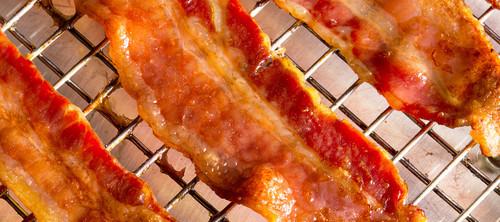5 Tips for Cooking Crispy Bacon

START YOUR BACON IN A COLD SKILLET
Trust
us. When we tossed cold bacon into a hot skillet, it started to brown
and crisp before the fat really started rendering out. That leaves you
with two choices: Keep sizzling your bacon until the fat’s cooked
through but the bacon burns, or take it off the heat and deal with
fatty, flabby bacon. On the other hand, when we added it to a cold pan
and then turned on the heat to medium, the fat had plenty of time to melt away, leaving us with crunchier (and less greasy) slices.
A CAST-IRON SKILLET COOKS BACON FASTER
For
our first stove-top cooking test, we pitted a 12-inch cast iron skillet
against a 12-inch stainless-steel skillet. When we started with cold
bacon in a cold skillet and cooked over medium heat, the taste and
texture were the same for the bacon from each skillet: nice and crunchy,
with a lovely smoky depth of flavor, and some deeper browned and
charred spots. But while the stainless-steel skillet took 11 minutes,
the cast-iron skillet took only 8.
ADD WATER TO THE SKILLET IF YOU WANT TO CRUMBLE THE BACON
We’d
heard from the folks over at America’s Test Kitchen that adding a bit
of cold water to your cold skillet with your bacon yields better,
crispier, bacon. So we gave it a go. It took a bit longer, but sure
enough, all the water evaporated and then the bacon started crisping as
it normally would. The result was thinner and crisper than the bacon
cooked in the skillet without water: it shattered easily, and was very
nice and crunchy. It wasn’t as salty, and we actually missed the thicker
crunch of traditional bacon, but this strategy would be perfect if you
wanted to use the bacon as a crumbled topping for, say, salad.
FOR MORE THAN 1 OR 2 SERVINGS, USE YOUR OVEN
Even
in a 12-inch skillet, you can only fit 5 to 6 slices of bacon. So if
you’re feeding a crowd, you want to heat up your oven instead. Baking
your bacon on a wire rack set over a rimmed baking sheet allows the
rendered fat to drip away from the bacon, helping it cook up even
crunchier than pan-frying. (While bacon should be started in a cold pan
if you’re cooking it on the stove-top, you can crank up the heat if
you're baking your bacon in the oven. We found a temp of 450°F gave
oven-baked bacon the same smoky depth as the stove-top kind. Just cook it
for 20 minutes to get perfectly sizzled slices.) Even better, you can
fit 10 to 12 slices on a rack, and it cooks without needing any
attention: no flipping, no rotating, and—best of all—no messy splatter
all over the stove.
COOKING BACON IN THE MICROWAVE IS SAD
In
the microwave, we cooked the bacon padded between several sheets of
paper towels on high until fully cooked and crisp, which took about
3 1/2 minutes in our machine. It was beautiful looking bacon: crinkly
and golden-brown, without any sign of char. But when we bit into it, it
wasn’t crisp enough, and it lacked the charred flavor we craved. Our
vote? Stick to the pan or the oven.

No comments:
Post a Comment